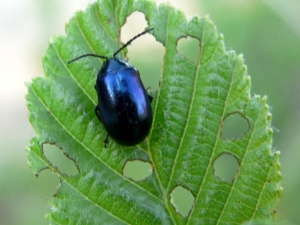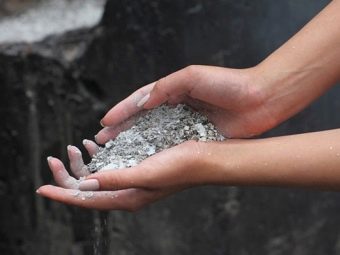Horseradish pests and how to deal with them

Horseradish is a regular guest in vegetable gardens in Russia.But even this relatively unpretentious plant can face a variety of enemies, so it is very important for gardeners and gardeners to know these “enemies” by sight.
Causes of
Among horseradish pests in the first place is to put babanukha. This insect has other names - cabbage leaf, horseradish leaf beetle. In addition to these two cultures, often babanuha attacks horse sorrel. These are bugs, whose body length is 0.35–0.4 cm. Insects are painted in dark green color, which look shiny and close in shape to a circle.
Babanukha usually hibernates in the surface layer of the earth, therefore its appearance is caused by the inattention of farmers to the neutralization of this layer. Exit to the surface occurs in the spring. One can notice the manifestations of aggression first on the weeds, since the leaf beetle eats first of all cultivated plants. Eaten leaves are brought to the state of the skeleton. Every 12 days comes a new wave of the pest. The leaf beetle is active in cloudy, wet weather. Of course, it does not depend on gardeners, but it is recommended to carefully care for the plantings and remove all weeds, thus avoiding conditions for the appearance of a pest.
It is very important to engage in the prevention of disease. If horseradish is healthy, it is much better resistant to insects. In addition, there is no need to intensely guess what caused the occurrence of holes or white spots on plants.
Holes in the foliage makes a wavy flea. Tiny arthropods should not set up gardeners in a benign way. These "miniature" horseradish fighters can make a kind of sieve from a strong large sheet in 5-7 days. Recognize the insect can be on the dark color and stripes of yellow tone on the back. It is almost impossible to collect them with your hands, because with the slightest movement, the instinct of the jump works. The wavy flea overwinters in the ground, so the indirect reason for its occurrence is also considered non-compliance with preventive measures. The insect brings the main damage already from the first days after the emergence of shoots, it develops the highest activity in hot dry days.
Cabbage moth is also a formidable opponent of the sharp plant. This butterfly has a wingspan of 30 mm. It is painted in brown tone, dark stripes can be seen on the front parts of the wings. The wintering of the caterpillars occurs in the soil, they are pulled out in June, and the formation of cocoons immediately begins. After 10 days, you can expect the most active aggression, when the second generation settles on the leaves. The danger lasts about a month, then the insects begin to prepare for wintering again.
Another pest is the cabbage bug. Recognize its invasion helps yellow foliage. If you do not deal with the effects of infection, it will soon become covered with necrotic spots. Flat red to black speck bug in length reaches 80-100 mm. He delivers the main blow against the backdrop of hot weather.
Prevention
Any negative event is easier to prevent than to overcome. To protect horseradish from pests, the following preventive measures should be applied:
- strict implementation of the norms of crop rotation;
- digging after cleaning;
- planting seedlings as early as possible;
- the use of safe deterrent drugs;
- soil disinfection.
The dug up earth helps to lay eggs of harmful insects upward. As a result, they freeze and in the spring can no longer give a new generation. An additional measure of protection is the dressing of the entire surface of the beds with a combination of ash and tobacco dust. The same mixed composition is very well manifested itself for the protection of vegetable plantations.
Scare away the pests, but only as long as they do not start the "meal", is such means as:
- household soap solution;
- tobacco dust;
- decoctions of husks of onions and chamomile.
At the stage of preparation for the first landing of horseradish should be checked so that tomatoes and root crops do not grow nearby.Moreover, the joint cultivation of them close to one season creates favorable conditions for pests.
It is recommended to choose the least wet areas and remove from the surface all fallen leaves, remnants of past vegetation. It is very important to loosen the ground thoroughly. And you should also continuously monitor the state of horseradish landings.
How to get rid?
Folk methods
If you failed to fully protect the hell thickets, and the pests are already attacking them, you will have to fight them more actively. It is not always advisable to use synthetic insecticides, since there are safer means. With a weak infection of horseradish babanukha, it is necessary to perform the following measures:
- remove it manually;
- use glue traps;
- shake insects on the underlying material.
To consolidate success, it is required to process horseradish with a combination of 20 shares of wood ash, 1 share of red pepper and 1 share of ground dry mustard. Cabbage moth is suppressed in roughly the same ways. But if there is a lot of it, it is required to use synthetic means. With the invasion of the cabbage bug it is worth fighting with onion or chamomile decoction. Spraying the plants is not the only option, you should add to the horseradish planting nasturtium or marigold.
Long-lasting results provide dusting of ash in combination with red pepper. It is required to sprinkle not only the leaves, but also the ground surrounding the plant. Suitable plant insecticide is a decoction of yarrow or wormwood.
Processing with natural preparations, including tincture with alcohol, should be carried out at least three times, leaving 4–5 days intervals. This will allow to evaluate the effectiveness of the impact and, if necessary, increase its intensity.
Chemicals
Treat hell store preparations need to be careful. Begin with a test on a single bush. Only when 24 hours have passed and no negative manifestations have been found, can the rest of the plants be treated. The use of synthetic reagents is recommended mainly for very severe infections. In such a situation, natural formulations with their effectiveness of about 30–40% are poorly suited.
Spraying should be carried out with strict compliance with safety requirements. By all means protect hands with gloves, and also put on points. It is recommended to wear a mask on the face, covering the mouth and nose. You can not consume fruits from plants treated with synthetic means before it takes 30 days. The drug "Fury" is used in the amount of 1 ampoule per 10 liters of liquid. The wavy flea is well suppressed by Foxim and Actellic. The very first treatment is carried out at the time of germination, then it is done at the beginning of bud formation and at the end of flowering.
On how to grow horseradish, so that it does not become a weed, see the following video.
























